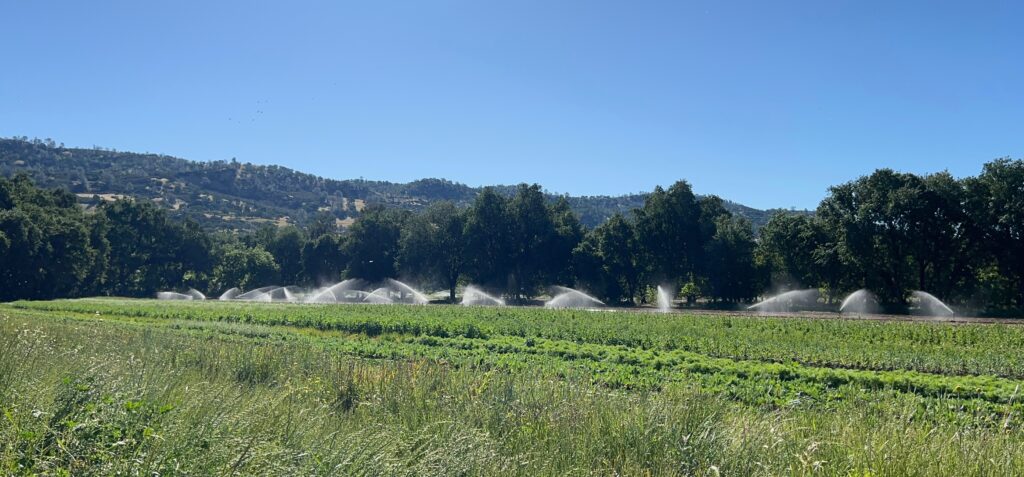
Notes from Under Ground
Underneath the soil that grows our food, in the rocks and sediment, there are vast stores of groundwater, sometimes connected with creeks and rivers, often critical for survival of deep-rooted trees and plants. In a rainy year, groundwater levels go up as rain percolates down into storage. In a dry year groundwater levels trend down as farmers and cities pump it out. This is a very simplified description of something that hydrologists spend a lot of time measuring and thinking about.
In 2014, because of concerns about groundwater levels trending downward a lot more than upward, California decided it was time to act. Drinking water wells in small towns of the San Joaquin Valley were going dry. Land was subsiding as aquifers collapsed, causing all kinds of infrastructure failures. Farmers were digging wells deeper and deeper. Rivers, creeks and plants that relied on groundwater were compromised as groundwater dropped out of reach.
The law passed back in 2014 (called the Sustainable Groundwater Management Act) was an optimistic compromise between state oversight and local control. Policymakers were hopeful that groundwater overdraft could be stopped by mutual restraint and agreement of local communities. The regulations set up a framework within which locals could develop and implement plans for bringing groundwater aquifers into a stable equilibrium. If these local efforts were unsuccessful, the state would step in and potentially start restricting pumping and levying fees.
Aquifers (called subbasins in this context) were categorized as “medium” or “high” priority, depending on how serious their groundwater-related issues were, and everyone was given 10 years to develop a plan and submit it to the state. In some cases, the state said that the plans were inadequate or incomplete while in others the plans were accepted and everyone rolled up their sleeves to get started. So far, in one case (the San Joaquin Valley Tulare Lake Subbasin) even the rewrite of the plan was deemed inadequate, and the State Water Resources Control Board stepped in.
Doing all this planning, hydrologic research, management, outreach, and so on gets expensive, and many rural counties don’t have a large tax base to draw on. There is one county where the Board of Supervisors also serves as the Board of Directors of the groundwater agency. They decided to levy a 29¢ per acre fee across the whole county (even on land where groundwater was not being pumped) to fund a pump registration program. They also arranged an internal transfer of several hundred thousand dollars from the public works department into their budget. People noticed, and got riled up. The county Grand Jury decided to investigate and ended up demanding that all the money be returned. “Local control”, a cornerstone principle of this approach to groundwater management has its ups and downs.
A common theme that has emerged over the last several decades in the Sacramento Valley is a steady increase in orchard plantings, often almonds, and frequently funded by big investment companies. Orchards can’t be fallowed in a drought and are said to “harden” water demand. Orchardists usually prefer groundwater over surface water for a number of reasons (it’s cheaper and available on demand, to name just two). The orchards seem often to pop up on ground that was previously unirrigated, causing overall increased pressure on groundwater. In one county, 9000 acres of irrigated eucalyptus trees were planted for lumber back in 1993, and 18 new wells were installed. The plan was to harvest eucalyptus for lumber on an 8-year cycle. Groundwater levels declined significantly due to pumping for the eucalyptus grove from 1993 to 2002, but then the project was abandoned and groundwater levels have started to recover. Unfortunately (for the groundwater) not all of the orchard stories have this ending.
We are now in the implementation stage of the groundwater management effort in California and no one expects it to be straightforward. Many farmers who have a lot at stake have no idea the process is underway. Proposed projects usually involve activities that some say could privatize groundwater resources, create conditions that will send more northern California water south, or potentially disadvantage smaller scale farmers. It’s an area for concern that we’ve highlighted in the Beet newsletter before.
A new Water Program at the Community Alliance with Family Farmers (CAFF) is researching conditions in different agricultural regions of California and conducting outreach to small-scale farmers to make them aware of local groundwater management plans. Groundwater overdraft in the Sacramento Valley is less serious than in southern parts of the state where most of the critically overdraft basins are located, or coastal regions where overdraft in groundwater basins leads to saltwater intrusion. Hopefully the projects and activities now underway in the Sacramento Valley will result in stabilizing groundwater levels before they get worse. In 2023, a wet water year, there was an increase in California’s overall groundwater storage for the first time since 2019, so you could say (cautiously) that we’re off to a good start.
Judith Redmond
Judith Redmond, one of the founding owners of Full Belly Farm is now researching Sacramento Valley groundwater management plans with CAFF as part of their Small Farmers and Sustainable Groundwater project.


